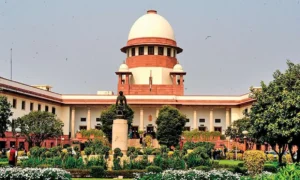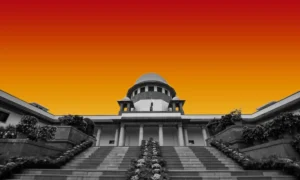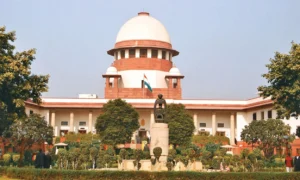
The Supreme Court on Monday directed the Government of the National Capital Territory of Delhi (GNCTD) to submit a detailed affidavit within two days, specifying the technical specifications and operational efficiency of the instruments used for recording the Air Quality Index (AQI) in the national capital.
The Bench of Chief Justice of India BR Gavai, Justice Vinod Chandran and Justice NV Anjaria passed the order in the wake of allegations that deliberate water sprinkling was being carried out in the vicinity of pollution-monitoring stations to manipulate AQI readings.
Amicus Curiae and Senior Advocate Aparajita Singh drew the attention of the Bench to media reports and video evidence alleging systematic water spraying around several Continuous Ambient Air Quality Monitoring Stations (CAAQMS), which led to distorted real-time air quality measurements.
Appearing for the Union Government, Additional Solicitor General Aishwarya Bhati contended that sprinkling was a part of routine dust-suppression operations taken across the city. She alleged that claims of outdated or manipulated data were being amplified for political effect.
The CJI then pointed out that he had himself witnessed the sprinkling around the Supreme Court premises.
The Amicus submitted during the hearing that the incidents of stubble burning were being under-reported.
The Bench, taking cognisance of the status report filed by the Commission for Air Quality Management (CAQM), said that it indicated a reduction from 28,000 incidents to 4,000.
Senior Advocate Singh responded that several field reports, experts, satellite-based assessments, and the CAQM itself had highlighted discrepancies in the report, suggesting that the figures did not reflect ground realities.
He further submitted that farmers were intentionally timing their stubble burning to evade satellite surveillance, quoting an analysis from a NASA scientist and media reports. The Amicus said the official count of farm fires may not reflect the true extent of the problem.
The ASG apprised the top court of the country that since the farmers lacked adequate turnaround time between paddy harvesting and wheat sowing, they were given the suggestion to dispose of the crop residue through burning.
The subsidy-backed machinery has been distributed to the peasants since 2018, she noted, adding that the State of Punjab could utilise the Central assistance worth Rs 100 per quintal to incentivise farmers to adopt eco-friendly stubble disposal methods.
Senior Advocate Gopal Sankaranarayanan drew the Court’s attention to the decreasing air quality in Delhi in 2025, saying that there was an urgent response to the terror attacks that claimed seven lives. Millions of people were dying here. Three out of 10 deaths in Delhi were caused due to air pollution.
Noting that 450 plus AQI was called as GRAP trigger, he said that 200 plus AQI was absolutely dangerous. A PM 2.5 entering a child’s lung would never leave, he added.
The Senior Advocate sought firm judicial intervention on the grounds that both the Environment Pollution (Prevention and Control) Authority and the CAQM had failed to arrest the crisis.
The Bench asked whether a year-long prohibition on stone crushers and certain construction machinery could be imposed. ASG Bhati opposed the suggestion, stating that such a blanket prohibition would be unworkable.
She argued that nations that have already achieved economic maturity were now imposing curbs that could impede India’s developmental trajectory. Pollution could not be addressed through knee-jerk measures, she noted.
The Court observed that if stubble burning incidents had indeed declined, other contributory sources of pollution, such as industrial emissions, construction dust, and vehicular output, may require closer scrutiny.
The Apex Court recorded in its order that graded restrictions under GRAP have been formulated by domain experts on the basis of scientific data. Since the Bench lacked technical expertise to override such assessments, it could not accept the submission that all activities in Delhi be halted, particularly when a substantial population depended on them for livelihood.
The top court of the country directed the Union Ministry of Environment, Forest and Climate Change (MoEFCC), along with the state governments of Punjab, Haryana, Uttar Pradesh, and Rajasthan, to undertake coordinated and time-bound mitigation measures in this regard and listed the matter for further hearing on November 19.
The Bench said it would examine the claims related to non-functional air quality monitoring stations in Delhi and farmers timing their crop residue burning to evade satellite surveillance on the next date of hearing, adding that it would also review the responses from Punjab, Haryana, and the CAQM on Wednesday.
📰 Crime Today News is proudly sponsored by DRYFRUIT & CO – A Brand by eFabby Global LLC
Design & Developed by Yes Mom Hosting





